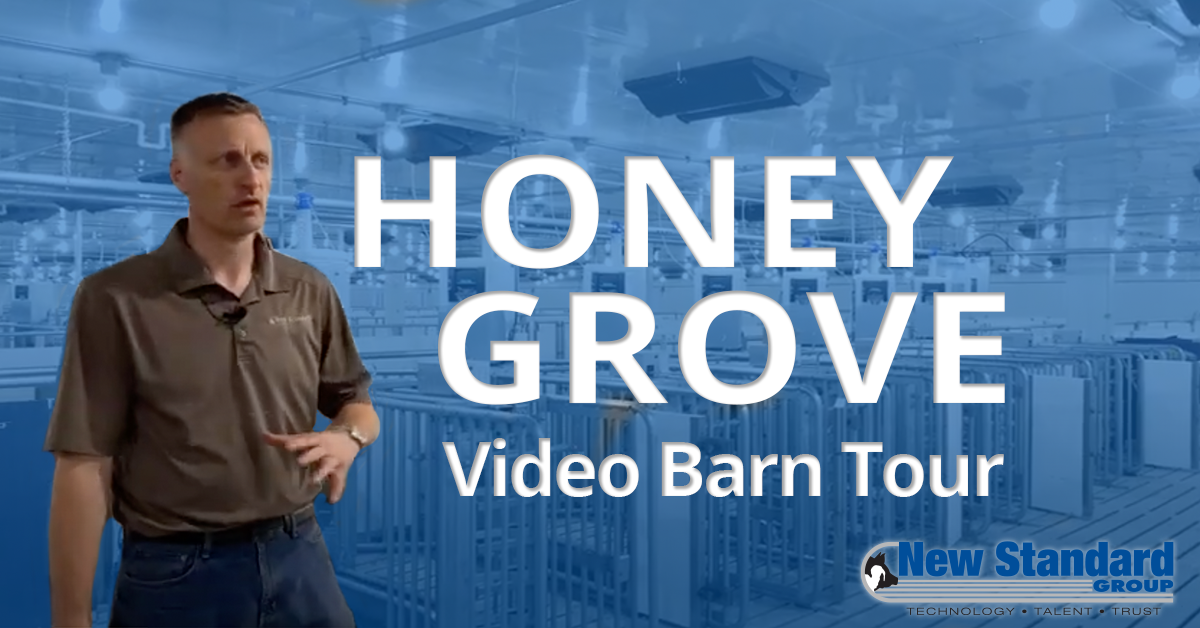
Located in Northwestern Missouri, Honey Grove a technology progressive hog barn, contacted the New Standard team design and create a new hog barn with the latest automation and comfort features to support up to 5,000 hogs.
Highlight of the video:
Gestation
"Designing for the sows should have a heavy focus on the gestation area," Tim states. The gestation area has Electronic Sow Feeding (ESF). There are pens designed specifically for sows and gilts so that gilts can interact with the pen differently than a sow who is more practiced. "The most important thing in design is the separation between the entrance to the feeding station and the exit."
The feeders all bring the sows and gilts into a common exit after feeding. It is important to have a separation between the animals that are full and the animals that are looking for food. Such animals can have different mindsets and hormonal balances between them. A lack of separation can needlessly raise the stress levels of animals, which can create chaos in a barn.
"You want to eliminate any stress oddities possible when it comes to feeding," Tim states.
Sow Feeding
It's important that the sow understands that no matter what, she will be fed. Food security is the most important factor in designing the barn to fit a sow. Correct design helps to eliminate the competition for food, fears over whether she will get enough, or whether she can eat on her schedule.
"We want to eliminate any kind of fear about their ability to get food," states Tim.
The New Standard team planned the feed protocols and attendant equipment in such a way where digestion starts before she is done eating. Feeding Rate is important, as you do not want to give feed so fast to the sow that she consumes it before digestion sets in. If digestion starts before she is done eating this can help with: changes in hormonal balances, signals to the brain that will alert her that she is getting full, reduces agitation because sow will not be looking for more food and will be satisfied thereby she will vacate a station willingly.
Planning the Feeding Rate for digestion, will allow the sow to leave on her own from the feeding station. This helps to reduce conflict between the sows as well. If she leaves on her own, and is satisfied, she will not hang around wanting seconds. "If we don't achieve that, we run the risk of her not wanting to leave and getting into a situation with another sow in the feeding station," Tim explains. " That is why this is a crucial step to get right."
The rate has to be well adjusted for the sows to ensure stress free environment, reduction of conflict, and furthermore reduction of noise. "If you do not give proper time for digestion to set in before a sow finishes," Tim warns. "You run the risk of sows gathering near the feed throughout the 24-hour feed cycle. They will be noisy and agitated because they are not secure that food will always be there."
Animal Flow in the Barn
When sows are done eating, they will exit forward into a common exit alley, which will direct them towards a Weight Monitoring Scale and then a separation gate if there is a need to separate anyone. This allows the producers to track the weight of the animals every day to see if the sow is getting enough nutrition. This scale can help determine whether a sow is on a curve or has a nutrition problem (too much/ not enough). The scale is exclusive to Nedap, which New Standard uses in the building of ESF barns. Built into the common separation/exit alley, technology will recognize if a sow has lost their RFID tag and they will automatically be sorted out to be handled. This eliminates the issue of sows going without feed.
Once the sows have exited the alley, they enter a large common area where social interaction will occur as most full animals now have freedom to do something other than think of food. There is, as Tim calls it: "a peep show", allowing sows to interact with the penned boar through a hole in the wall. This helps to indicate which sow is in heat, which is tracked using the RFID tags. This is important to the flow of the barn in terms of the social interaction of the animals. Why?
"The rising estrogen hormones in sows coming back in heat can mess with the chemistry of the other sows," Tim explains. "This can lead to disorder within the pen if not addressed quickly." With the tracking features of the RFID tags, producers will be able to monitor those changes in the sow.
The common area will allow producers to see how the sows interact with each other. Sows will create groups, called "cliques". These sows create nesting patterns, where around 10 in a clique will congregate day after day.
The New Standard team also uses PanelTim, a great bio-secure plastic for penning. "It's easy to install and strong," Tim explains.
Stress Reduction by Design
Sows have three needs:
- She needs to know where she eats.
- She wants to know where she sleeps.
- She wants to know where to do her business.
The New Standard team, with those 3 factors in mind, designed the barn to be a horse-shoe shape style, or oval to accommodate the cycle of the sows, but Tim says that's not all. "The goal is that producers will understand what the sow needs, so by the time they get into the nesting area of the pen, digestion has fully set in, and they are ready for a nap." Knowing how to make a sow comfortable, reduce the stress, and understand her needs is essential. " It's a great way to create healthy interactions, and lower the stress levels, because if a sow is irritated, she doesn't keep it to herself."
Farrowing Pen
Breeding stalls - a place to house sows for a couple of days for breeding every week. They will typical return an animal to the large pens once the "in heat" cycle is complete.
Electronic feeders are installed in the breeding portion of the barn. This helps the sows regain nutrition and energy that is depleted from producing milk to the piglets, and helps to recondition her body in preparation for returning to gestation.
"What I find interesting in this barn design is that Honey Grove custom-made all the crates with stainless steel," Tim says with appreciation. "I find that very cool."
Overall
Going from stall barns to open penning with ESF stations done right not only helps the sows, but it also helps the workmen and producers in the barn as well. "It helps raise morale if done right," Tim states.
If you liked this video please make sure you subscribe to our blog for the latest!





